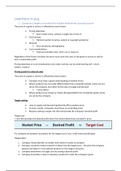CHAPTER 8: Pricing
1. Compute a target cost when the market determines a product price
The price of a good or service is affected by many factors
• Pricing objectives
▪ Gain market share, achieve a target rate of return
• Environment
▪ Political reaction to prices, patent or copyright protection
• Demand
▪ Price sensitivity, demographics
• Cost considerations
▪ Fixed and variable costs, short-run or long-run
Regardless of the factors involved, the price must cover the costs of the good or service as well as
earn a reasonable profit
Pricing objectives en cost considerations zijn onder controle van de onderneming zelf = intern
andere 2 extern!
Pricing goods for external sales
The price of a good or service is affected by many factors.
• Company must have a good understanding of market forces
• Where products are not easily differentiated from competitor goods, prices are not
set by the company, but rather by the laws of supply and demand
▪ = price takers
• Where products are unique or clearly distinguishable from competitor goods, prices
are set by the company
Target costing
• Laws of supply and demand significantly affect product price
• To earn a profit, companies must focus on controlling costs
• Requires setting a target cost that will provide the company’s desired profit
Target cost
= cost that provides the desired profit when the market determines a product’s price
If a company can produce its product for the target cost or less, it will meet its profit goal
Stappenplan:
1. Company should identify its market niche where it wants to compete
2. Company conducts market research to determine the target price – the price the company
believes will place it in the optimal position for the target consumers
3. Company determines its target cost by setting a desired profit
4. Company assembles a team to develop a product to meet the company’s goals
,QUESTIONS:
Target cost related to price and profit means that:
a. Cost and desired profit must be determined before selling price.
b. Cost and selling price must be determined before desired profit.
c. Price and desired profit must be determined before costs.
d. Costs can be achieved only if the company is at full capacity.
2. Compute a target selling price using cost-plus pricing
Cost-plus pricing
• In an environment with little or no competition, a company may have to set its own
price
• When a company sets price, the price is normally a function of product cost: cost-
plus pricing
• Approach requires establishing a cost base and adding a markup to determine a
target selling price
• In determining the proper markup, a company must consider competitive and
market conditions
• Size of the markup (the “plus”) depends on the desired return on investment for the
product:
ROI = net income / invested assets
ILLUSTRATION:
Thinkmore Products is in the process of setting a selling price on its new video camera pen. It is a
functioning pen that records up to 2 hours of audio and video. The per unit variable cost estimates
for the new video camera pen are shown:
In addition, Thinkmore has the following fixed costs per unit at a budgeted sales volume of 10,000
units.
,Thinkmore has decided to price its new video camera pen to earn a 20% return on its investment
(ROI) of €2,000,000.
Markup = 20% ROI of €2,000,000
DESIRED ROI PERCENTAGE X AMOUNT INVESTED
_____________________________________________ = MARKUP (DESIRED ROI PER UNIT)
UNITS PRODUCED
Expected ROI = (20% x €2.000.000) / 10.000 units = €40
€ 60
€ 65
€125
€ 40
€ 165
Use markup on cost to set a selling price:
• Compute the markup percentage to achieve a desired ROI of €40 per unit:
Markup (desired ROI per unit) / total unit cost = markup Percentage
€40 / €125 = 32%
• Compute the target selling price:
Total Unit Cost + (total unit cost X markup percentage) = Target Selling Price per Unit
€125 + ( €125 X 32% ) = €165
Thinkmore should set the price for its video camera pen at €165 per unit.
, Limitations of cost-plus pricing
• Advantage of cost-plus pricing: easy to compute
• Disadvantages:
▪ Does not consider demand side:
• Will the customer pay the price?
▪ Fixed cost per unit changes with change in sales volume:
• At lower sales volume, company must charge higher price to meet
desired ROI
ILLUSTRATION:
If budgeted sales volume for Thinkmore’s Products was 5,000 instead of 10,000, Thinkmore’s variable
cost per unit would remain the same. However, the fixed cost per unit would change as shown:
Thinkmore's desired 20% ROI now results in a €80 ROI per unit [(20% x €2,000,000) ÷ 5,000].
Thinkmore computes the selling price at 5,000 units as shown:
At 5,000 units, how much would Thinkmore mark up its total unit costs to earn a desired ROI of €80
per unit.
= (desired ROI per unit) / (total unit cost)
= €80 / €190 = 42,11%
The target selling price would then be €270, as indicated earlier:
€190 + (€190 X 42,11% ) = €270
Stel: omgekeerd effect = budgeted sales volume vermeerder ipv verminderd
→ fixed costs and ROI can be spread over more units.
➔ cost-plus model of pricing will achieve its desired ROI only when Thinkmore sells the quantity it
budgeted.
!! if actual volume is much less (dus veel minder aka het omgekeerd effect) than budgeted volume,
Thinkmore may sustain losses unless it can raise its prices !!




